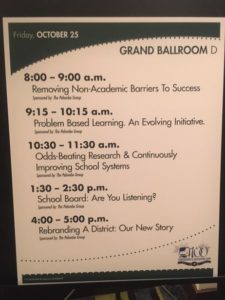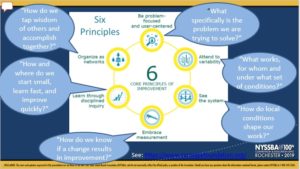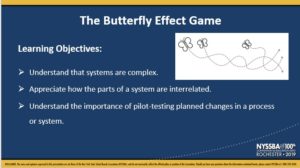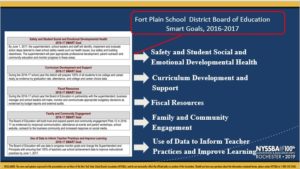Odds-Beating Schools & Continuously Improving School Systems: NYKids Presents on School Boards’ Roles at 2019 NYSSBA Annual Convention
By Amanda J. Lester
On October 25, 2019 NYKids presented at the New York State School Board Association’s (NYSSBA) 100th Annual Convention and Education Expo in Rochester, NY about findings from the NYKids’ Career and College Readiness study and provided improvement resources developed from that work.
Each year, the NYSSBA convention brings together more than 2,000 education leaders to discuss needs, interests, and issues of concern to school board members across New York State. This presentation offered convention attendees an overview of how NYKids’ research can support district-wide improvement efforts by combining odds-beating school research and improvement science-based processes to help school improvement teams identify shared goals and use strategies to improve student outcomes.
Seeing the System Together: Improvement Science as a Framework for Collaborative Problem-Solving
The session started by highlighting the challenge most often faced by educators as they seek to apply research to improve student learning: determining how to draw upon lessons learned in other educational contexts to develop processes for improvement that will work effectively in their own schools and districts.
Improvement science, as described through The Six Core Principles of Improvement, was referenced as a framework to help address this challenge because it provides a user-centered, problem-focused approach for school board members to collaborate with district leaders, school leaders, teachers, and support staff to make deliberate, strategic decisions for improvement and to share ownership for improvement efforts.
To engage in improvement work, it is vital to understand how processes interact within systems, and particularly, how a change to one part of a system may have an unforeseen effect on another part of the system. To explore this idea, session attendees were invited to take part in an interactive activity designed around the “Butterfly Effect”.
The Butterfly Effect centers on a phenomenon that has been observed in all manner of systems: that small, localized changes made to a complex system can have larger effects on a different part of the system. The interactive activity required participants to select two other participants in the room, and when prompted, move in a way that enabled them to remain equidistant from the two selected individuals. After several repetitions of the game, participants were asked to describe their experiences. Some key ideas shared included:
– “I had difficulty deciding where to go because I could not control where they went.”
– “I knew where I wanted to go, but that changed as they changed direction.”
– “I could not see where they went easily because of the chaos [while moving] and because I am so short.”
These quotes speak to a number of important aspects of change and change efforts, including the importance of (a) seeing the system in its entirety before engaging in a change effort, (b) engaging in close attention to effects on each part of a system as changes are made, and (c) soliciting input from diverse stakeholders before, during, and after a change, so that people can learn with and from each other.
Applying Lessons Learned from Odds-Beating Schools through COMPASS: A Case Study
Key take-aways from the activity focused on the challenges presented when improvement processes are designed without consideration to the effects occurring within and across systems. To offer a process that would account for this, the next part of the presentation focused on promising practices in odds-beating schools identified through NYKids’ research and how that research melds with improvement science to support continuous school improvement through the NYKids’ COMPASS process.
COMPASS is a direct support school improvement program that uses a multi-step process to:
- Take the pulse of your school by comparing your practices to those of odds-beating schools serving challenging populations in New York State.
- Select levers for improvement by examining practices of odds-beating schools through case study analysis.
- Determine action steps and plan for evidence-guided decision-making using improvement science tools.
To demonstrate how COMPASS works in action, a case study of the Fort Plain Central School District was shared to provide an example of how improvement was achieved through a collaboration between the school board, district and school leaders, and school staff. (This case study is also featured in a 2019 research article.)
The school board’s involvement as a collaborative partner in Fort Plain’s COMPASS process included developing SMART goals for district-wide improvement, that in turn, supported the implementation of more specific, student-centered goals at the school building level. The collaboration between school board members, the district superintendent, and school building leaders was crucial in enabling school staff to feel supported in implementing action plans based on these co-created goals. As a result, many of the school-level goals were reached within two years of starting the process.
NYKids’ Resources to Support School Boards in Collaborating for Continuous Improvement
As school board members seek ways to engage in collaborative problem-solving with school district leaders, school leaders, and instructional and support staff to improve student outcomes, new processes and resources, like COMPASS, will be needed to guide that work.
Along with providing direct support through COMPASS, NYKids offers a multitude of resources, including case studies, research reports and articles, and the NYKids’ Performance Tracker, a database that provides information about how your school’s performance compares to odds-beating schools and other schools with similar demographics in New York State. To learn more, visit: https://ny-kids.org/.




